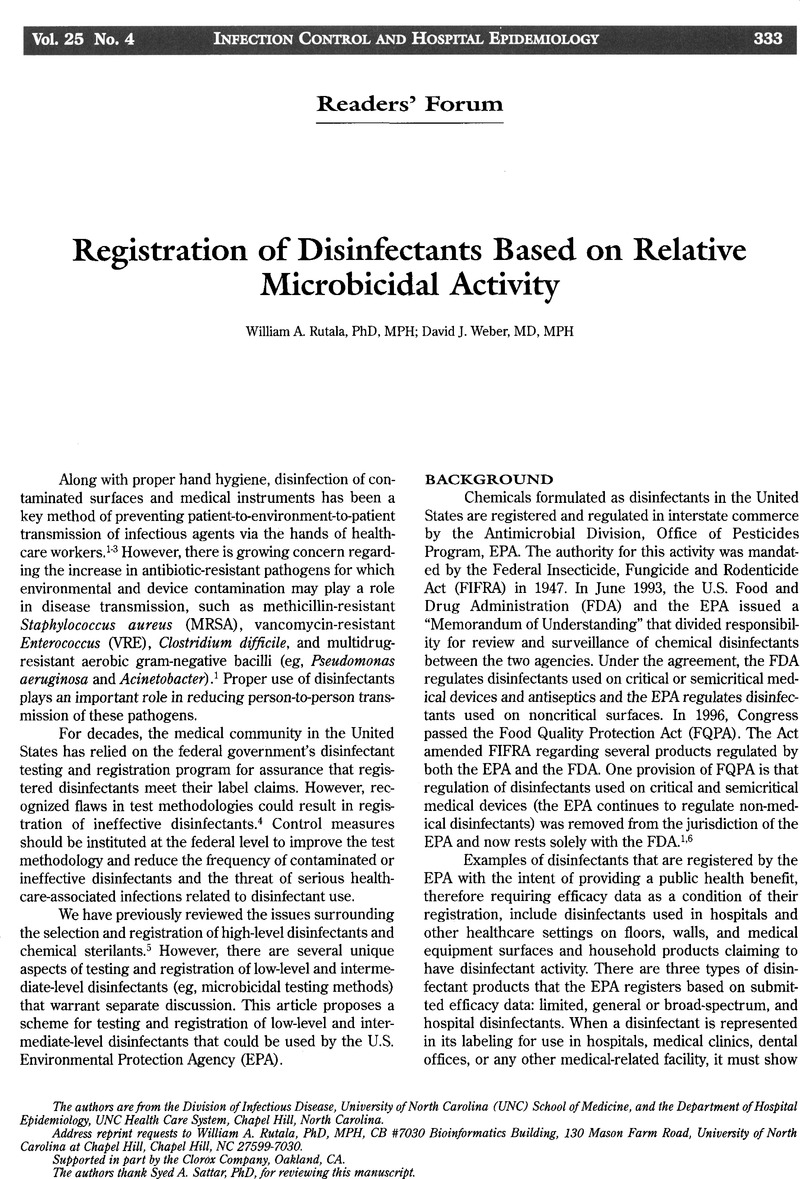Crossref Citations
This article has been cited by the following publications. This list is generated based on data provided by Crossref.
Mazzola, Priscila Gava
Jozala, Angela Faustino
Novaes, Letícia Célia de Lencastre
Moriel, Patricia
and
Penna, Thereza Christina Vessoni
2009.
Minimal inhibitory concentration (MIC) determination of disinfectant and/or sterilizing agents.
Brazilian Journal of Pharmaceutical Sciences,
Vol. 45,
Issue. 2,
p.
241.
Okunishi, Junji
Nishihara, Yutaka
Maeda, Shirou
and
Ikeda, Masahiro
2009.
In vitro evaluation of the antimicrobial activity of HM-242, a novel antiseptic compound.
The Journal of Antibiotics,
Vol. 62,
Issue. 9,
p.
489.
Malato, S.
Fernández-Ibáñez, P.
Maldonado, M.I.
Blanco, J.
and
Gernjak, W.
2009.
Decontamination and disinfection of water by solar photocatalysis: Recent overview and trends.
Catalysis Today,
Vol. 147,
Issue. 1,
p.
1.
OKUNISHI, JUNJI
NISHIMURA, HIROSHI
TAKADA, AKIRA
INADA, TAKAE
MAEDA, SHIROU
MAEDA, TAKUYA
NISHIHARA, TSUTOMU
KOMEMUSHI, SADAO
and
SAKAGAMI, YOSHIKAZU
2010.
Bactericidal Effect of HM-242, a Novel Disinfectant, against Pseudomonas aeruginosa.
Biocontrol Science,
Vol. 15,
Issue. 1,
p.
7.
Mittal, Himanshu
Parks, Simon R.
Pottage, Thomas
Walker, James T.
and
Bennett, Allan M.
2011.
Survival of Microorganisms on HEPA Filters.
Applied Biosafety,
Vol. 16,
Issue. 3,
p.
163.
Berberidou, Chrysanthi
Paspaltsis, Ioannis
Pavlidou, Eleni
Sklaviadis, Theodoros
and
Poulios, Ioannis
2012.
Heterogenous photocatalytic inactivation of B. stearothermophilus endospores in aqueous suspensions under artificial and solar irradiation.
Applied Catalysis B: Environmental,
Vol. 125,
Issue. ,
p.
375.
Jaglic, Zoran
Červinková, Dana
Vlková, Hana
Michu, Elleni
Kunová, Gabriela
and
Babák, Vladimír
2012.
Bacterial biofilms resist oxidising agents due to the presence of organic matter.
Czech Journal of Food Sciences,
Vol. 30,
Issue. 2,
p.
178.
Gómez-Couso, H.
Fontán-Sainz, M.
Fernández-Ibáñez, P.
and
Ares-Mazás, E.
2012.
Speeding up the solar water disinfection process (SODIS) against Cryptosporidium parvum by using 2.5l static solar reactors fitted with compound parabolic concentrators (CPCs).
Acta Tropica,
Vol. 124,
Issue. 3,
p.
235.
Rutala, William A.
and
Weber, David J.
2014.
Selection of the Ideal Disinfectant.
Infection Control & Hospital Epidemiology,
Vol. 35,
Issue. 7,
p.
855.
Favero, Martin S.
and
Arduino, Matthew J.
2014.
Biological Safety.
p.
373.
Giannakis, Stefanos
López, María Inmaculada Polo
Spuhler, Dorothee
Pérez, José Antonio Sánchez
Ibáñez, Pilar Fernández
and
Pulgarin, César
2016.
Solar disinfection is an augmentable, in situ-generated photo-Fenton reaction—Part 2: A review of the applications for drinking water and wastewater disinfection.
Applied Catalysis B: Environmental,
Vol. 198,
Issue. ,
p.
431.
Weber, David J.
Rutala, William A.
Fischer, William A.
Kanamori, Hajime
and
Sickbert-Bennett, Emily E.
2016.
Emerging infectious diseases: Focus on infection control issues for novel coronaviruses (Severe Acute Respiratory Syndrome-CoV and Middle East Respiratory Syndrome-CoV), hemorrhagic fever viruses (Lassa and Ebola), and highly pathogenic avian influenza viruses, A(H5N1) and A(H7N9).
American Journal of Infection Control,
Vol. 44,
Issue. 5,
p.
e91.
Haase, Hajo
Jordan, Lisa
Keitel, Laura
Keil, Claudia
Mahltig, Boris
and
Mishra, Yogendra Kumar
2017.
Comparison of methods for determining the effectiveness of antibacterial functionalized textiles.
PLOS ONE,
Vol. 12,
Issue. 11,
p.
e0188304.
Abeledo-Lameiro, María Jesús
Reboredo-Fernández, Aurora
Polo-López, María Inmaculada
Fernández-Ibáñez, Pilar
Ares-Mazás, Elvira
and
Gómez-Couso, Hipólito
2017.
Photocatalytic inactivation of the waterborne protozoan parasite Cryptosporidium parvum using TiO 2 /H 2 O 2 under simulated and natural solar conditions.
Catalysis Today,
Vol. 280,
Issue. ,
p.
132.
Polo-López, María Inmaculada
Nahim-Granados, Samira
and
Fernández-Ibáñez, Pilar
2018.
Applications of Advanced Oxidation Processes (AOPs) in Drinking Water Treatment.
Vol. 67,
Issue. ,
p.
155.
Polo-López, M. Inmaculada
Martínez-García, Azahara
Abeledo-Lameiro, Maria Jesus
H. Gómez-Couso, Hipolito
E. Ares-Mazás, Elvira
Reboredo-Fernández, Aurora
Morse, Tracy D.
Buck, Lyndon
Lungu, Kingsley
McGuigan, Kevin G.
and
Fernández-Ibáñez, Pilar
2019.
Microbiological Evaluation of 5 L- and 20 L-Transparent Polypropylene Buckets for Solar Water Disinfection (SODIS).
Molecules,
Vol. 24,
Issue. 11,
p.
2193.
Abeledo-Lameiro, María Jesús
Polo-López, María Inmaculada
Ares-Mazás, Elvira
and
Gómez-Couso, Hipólito
2019.
Inactivation of the waterborne pathogen Cryptosporidium parvum by photo-Fenton process under natural solar conditions.
Applied Catalysis B: Environmental,
Vol. 253,
Issue. ,
p.
341.
Weber, David J.
Sickbert-Bennett, Emily E.
Kanamori, Hajime
and
Rutala, William A.
2019.
New and emerging infectious diseases (Ebola, Middle Eastern respiratory syndrome coronavirus, carbapenem-resistant Enterobacteriaceae, Candida auris): Focus on environmental survival and germicide susceptibility.
American Journal of Infection Control,
Vol. 47,
Issue. ,
p.
A29.
Ozbun, Michelle A.
Bondu, Virginie
Patterson, Nicole A.
Sterk, Rosa T.
Waxman, Alan G.
Bennett, Erica C.
McKee, Rohini
Sharma, Ankur
Yarwood, Jeremy
Rogers, Marc
and
Eichenbaum, Gary
2021.
Infectious titres of human papillomaviruses (HPVs) in patient lesions, methodological considerations in evaluating HPV infectivity and implications for the efficacy of high-level disinfectants.
EBioMedicine,
Vol. 63,
Issue. ,
p.
103165.
Moody, Cary A.
Rutala, William A.
Gergen, Maria F.
Anderson, Deverick J.
Sickbert-Bennett, Emily E.
and
Weber, David J.
2022.
Susceptibility of human papillomavirus 16 to disinfectants.
Infection Control & Hospital Epidemiology,
Vol. 43,
Issue. 3,
p.
397.



